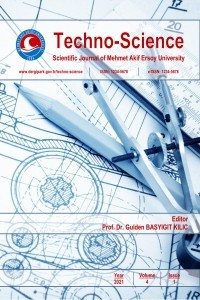Deep Learning in Marble Slabs Classification
Deep Learning in Marble Slabs Classification
The process of classification of marble slabs has an important place in terms of construction sector and demands. Despite the advanced mines and construction equipment in Turkey and the world, the separation of cut marble process is a problem that has not been solved yet. The lack of a standard for the classification of marbles and the use of human factors for this process lead to erroneous and inefficient determinations. In this study, for the first time the Deep Learning method has been tried on marbles, and the components obtained from Deep Learning layers have been examined and the success of classification has measured. Thanks to the successful results, the basics of the Deep Learning network have been laid for future marble databases.
Keywords:
Deep Learning, Marble Image Processing, Convolutional Neural Networks,
___
- [1]. Goodfellow, I., Bengio, Y., & Courville, A. (2016). Derin Öğrenme. Buzdağı Yayınevi, Ankara.
- [2]. Şişeci, M., & Cetişli, B. (2012). Traverten plaka taşlarda sınıfların K-ortalamalar ve bulanık C-ortalamalar kümeleme yöntemleri ile belirlenmesi. Süleyman Demirel Üniversitesi Fen Bilimleri Enstitüsü Dergisi, 16(3), 238-247.
- [3]. Martinez-Alajarin, J., Luis-Delgado, J. D., & Tomas-Balibrea, L. M. (2005). Automatic system for quality-based classification of marble textures. IEEE Transactions on Systems, Man, and Cybernetics, Part C, 35(4), 488–497.
- [4]. Selver, A. M. & Akay, O. (2009). Evaluating clustering methods for classification of marble slabs in an automated industrial marble inspection system. Int. Conf. On Electrical and Electronics Engineering, ELECO, 115-119.
- [5]. Benavente, N. & Pina, P. (2009). Morphological segmentation and classification of marble textures at macroscopical scale. Computers & Geosciences, 35(6), 1194-1204.
- [6]. López, M., Martínez, J., Matías, J. M., Taboada, J., & Vilán, J. A. (2010). Functional classification of ornamental stone using machine learning techniques. Journal of Computational and Applied Mathematics, 234(4), 1338-1345.
- [7]. Şişeci, M., Metlek, S., & Cetişli, B. (2014). Accelerating the image segmentation using sub-block technique and clustering methods. Journal of the Faculty of Engineering and Architecture of Gazi University, 29(4), 655-664.
- [8]. Turhal, Ü. Ç., Düğüncü, S., & Dener, G. (2015). Mermer plakalarında görüntü işleme teknikleri ile yüzey pürüzlülüğünün değerlendirilmesi. Bilecik Şeyh Edebali Üniversitesi Fen Bilimleri Dergisi, 2(1), 9-18.
- [9]. Moghaddam, H. K., Rajaei, A., & Moghaddam, H. K. (2018). Marble slabs classification system based on image processing (ark marble mine in Birjand). Civil Engineering Journal, 4(1), 107-116.
- [10]. Kemaloglu, N., Aydogan, T., & Metlek, S. (2018). Classification of travertine tiles with supervised and unsupervised classifiers and quality control. International Journal of Engineering and Technology, 10(3), 221-226.
- [11]. Hinton, G. E., Osindero, S., & Teh, Y. W. (2006). A fast learning algorithm for deep belief nets. Neural computation, 18(7), 1527-1554.
- [12]. Bengio, Y., Lamblin, P., Popovici, D., & Larochelle, H. (2007). Greedy layer-wise training of deep networks. In Advances in neural information processing systems, 153-160.
- [13]. Ranzato, M. A., Poultney, C., Chopra, S., & Cun, Y. L. (2007). Efficient learning of sparse representations with an energy-based model. In Advances in neural information processing systems, 1137-1144.
- [14]. Bengio, Y., & LeCun, Y. (2007). Scaling learning algorithms towards AI. Large-scale kernel machines, 34(5), 1-41.
- [15]. Delalleau, O., & Bengio, Y. (2011). Shallow vs. deep sum-product networks. In Advances in Neural Information Processing Systems, 666-674.
- [16]. Pascanu, R., Gulcehre, C., Cho, K., & Bengio, Y. (2014). How to construct deep recurrent neural networks. In Proceedings of International Conference on Learning Representations (ICLR).
- [17]. Montufar, G. F., Pascanu, R., Cho, K., & Bengio, Y. (2014). On the number of linear regions of deep neural networks. In Advances in neural information processing systems, 2924-2932.
- [18]. Krizhevsky, A., Sutskever, I., & Hinton, G. E. (2012). Imagenet classification with deep convolutional neural networks. In Advances in neural information processing systems (pp. 1097-1105).
- [19]. Szegedy, C., Liu, W., Jia, Y., Sermanet, P., Reed, S., Anguelov, D., ... & Rabinovich, A. (2015). Going deeper with convolutions. In Proceedings of the IEEE conference on computer vision and pattern recognition, 1-9.
- [20]. Russakovsky, O., Deng, J., Su, H., Krause, J., Satheesh, S., Ma, S., Huang, Z., Karpathy, A., Khosla, A., Bernstein, M., Berg, A. C., & Fei-Fei, L. (2015). ImageNet large scale visual recognition challenge. IJCV.
- [21]. Gonzalez, R. C., & Woods, R. E. (2014). Sayısal Görüntü İşleme. Palme Yayınevi, Ankara.
- [22]. Espinoza, M. A., Alférez, G. H., & Castillo, J. (2018). Prediction of Glaucoma through Convolutional Neural Networks. Int'l Conf. Health Informatics and Medical Systems.
- [23]. Mathworks, (2018). The MathWorks, Inc. Erişim tarihi: 01.11.2018. https://www.mathworks.com/help/deeplearning/ug/introduction-to-convolutional-neural-networks.html
- Yayın Aralığı: Yılda 2 Sayı
- Başlangıç: 2018
- Yayıncı: Burdur Mehmet Akif Ersoy Üniversitesi
Sayıdaki Diğer Makaleler
Utilization of waste heat from exhaust gases of gasoline generator for water heating
Nicholas MUSA, James OKEGBİLE, Adeola OWOJAİYE
Deep Learning in Marble Slabs Classification
İhsan PENÇE, Melike ŞİŞECİ ÇEŞMELİ
Energy potential from gasification of agricultural residues in Burdur, Turkey
